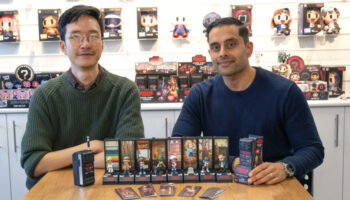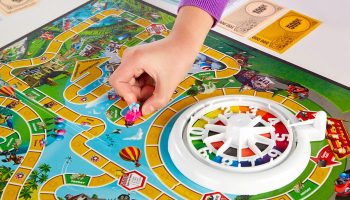Elizabeth Ganrude – Senior Manager of Product Design at Learning Resources – on teamwork, feeding creativity… And having award-winning ideas

Elizabeth Ganrude is Senior Manager of Product Design at Learning Resources.
In a rare interview, Liz here talks to us about empathy, how she feeds her creativity, the team she’s with… And repeatedly having award-winning ideas.
Liz! A great pleasure to catch up; thanks for making time. Your surname, Ganrude! Excellent; strong, rare… Do you know its origin?
It’s my married name, but I can appreciate its uniqueness! My husband’s great-great grandparents emigrated from Norway and settled in a small, beautiful town in the bluffs of south-eastern Minnesota. At some point in history they tagged an “e” on at the end making it “rude” rather than “rud”.
It does sound Nordic… Okay! Let’s start at the beginning: with what did you play when you were growing up?
I was constantly making up my own games and scavenger hunts. When I started babysitting for neighbours and friends, I’d make “lesson plans” with personalised games and activities.
Skipping to 2020, you’re the brains behind Toy of The Year Award winner, Coding Critters… This is a STEM concept that promotes preschool learning with screen-free coding. Tell us about it…
That’s flattering, but I’m only one of the many brains behind it. Overall design, aesthetics, and accessory piece function were my focus. It was a major team accomplishment that included a huge effort from Michael Blaustein, Tom Runtz, Brian McMahon, and Barb Plain – not to mention our creative and marketing teams.

And how did it come about?
Coding Critters started around the idea of how kids thoroughly enjoy robotic or other interactive pets. After success with the Learning Resources robot mouse, we decided to push the theme – and children’s imaginations – by combining coding with a fun playset. The goal was to create an engaging toy that also serves as a simple-step-coding tool, all to help kids envision and learn the basics of creating a simple code.
It’s a great toy – but I wouldn’t know where to start with it! What were the challenges?
There were two main challenges. First, creating primary critter characters that were cute, approachable, and unique looking. There are a lot of cute interactive pets out there! I needed to make sure they stood out but were identifiable and relatable to consumers, while having space for all the electromechanical components, such as the programming buttons that children press to create code.
And the second big challenge?
That was the accessory pieces… We knew we wanted those to provide additional learning through STEM principles, but not have them feel overly engineered or intimidating. After a lot of ideation and 3D print prototypes, we found that the slide provided a great setting for imaginative play, but also integrated coding. It was fun for children to drop the mini pet down the slide, then program the big pet to retrieve it…

In a scenario like that, children are coding as an essential part of their play. We also included launchers in various forms for kids to learn about motion, physics, and simply to accommodate the many scenarios children imagine when you give them “one more thing”. A phrase my three-year-old uses all the time – “I just need one more thing.”
Like a weird episode of Columbo! So in terms of the process, how did you get going?
This started with a lot of research from our project managers and then a lot of brainstorming as a team. Once we had essential features identified, it was handed off to me. I started with character sketches. I do most of my sketching or concepting in 3D. It’s easier for me to see things proportionally from the get-go, and then I’m only a few steps from 3D printing/prototyping. After creating a dozen different animal characters, we did some surveys to get a read on which characters resonated with people.
You surveyed an audience to choose the animal types?
Yes, so we know we’re starting on the best footing! That research led us to moving forward with a dog, cat and dinosaur… With a bunny being a close fourth! After choosing these characters, I was able to dig into accessory pieces. Completing the accessories included a lot of ideating, building in 3D, and 3D printing and prototyping to figure out fully-functional sets. While working on the accessory pieces, we were concurrently working with our vendors in China to work out the internal electromechanical parts of our little “robot under the hood”…

Meaning the tech aspects themselves?
Exactly – the motors, programming of sounds and movement; the general functions. After multiple prototypes and testing rounds, we had our sets!
Brilliant. You make it sound easy! And as well as picking up a 2020 TOTY, you also won one for Innovative Toy of the Year 2019: Botley the Coding Robot. If you had to guess, what would you say gives your ideas appeal?
I believe a lot of it must be due to the unique makeup of our team. We’re always trying to take big – and sometimes intimidating – concepts and distil them down to an understandable user-friendly form. We’ve done it with our various coding products, and we do it with a ton of educational products. We’ve been able to offer some unique solutions for improving fine motor skills in kids, teaching basic coding with our robots, and being a resource for a variety of educational topics.

You’re very quick to share credit! What’s your focus when you design, though?
My focus has been creating items that are “just unique enough”, as well as appealing to both parents and children. I would call my style “simple”, but in most of what I do, I work to pack in a lot of function with multiple ways to play. It’s wonderful – and sometimes surprising – to see the many ways kids may use a toy. I do my best to guess what they might do with a certain designs, and try and accommodate!
Great answer… I love the phrase, “just unique enough”. So on that last point, you’re clearly – as a designer – trying to empathise with people. But who, specifically? And how do you do that?
Kids and parents for sure! And thanks to online reviews, we now have an abundance of first-person narratives illustrating many of the concerns parents have over children’s products. Some are modern, some are ages-old… To empathise with a child is easier now that I’m a parent to my own. Child development has been an interest of mine for a long time… And I’ve gotten many insights into a child’s point of view through co-workers, friends, and family.
So let me ask you this: of which achievements are you most proud?
I’m most proud of the array of children’s products I’ve helped create. I started my career concepting and designing higher-end wooden toys and toddler furniture for a start-up. Now – at Learning Resources – I’ve stretched my skill set to include designing building sets, cute and approachable fine-motor-skill-improving characters, coding robots and other STEM products. Each of these categories requires a different way of thinking and designing.

I’m curious, then: if you could go back in time and give your younger self advice on entering the toy-and-game industry, what would you say?
Learn more engineering, material, and mechanical principles! Knowing how to make things visually impactful is important as an industrial designer, but so is understanding and designing how things will function as well as be made. You can rely on engineers for this, but it helps to have an understanding yourself.
And if I were hoping to become a better designer, what would I look to do?
Career-wise I would choose a broad industry you have an interest in… Medical devices, kitchenware, clothing, toys & games – whatever – and learn as much as you can about that industry’s staple brands/products, trends, common materials and manufacturing techniques. Personal-skill-wise I would always cultivate and sell what you do best, while nibbling away at the skills you feel are lacking. I often find putting a toe in the water of new tools or skills gives you an idea how useful or fun they may be.
I just have a couple more things! How do you feed your creativity?
A creative job can be very mentally exhausting. To keep creativity alive, I find I need quiet time – things like landscaping and gardening help me to relax my mind. I’m always surprised by how ideas can get sorted and problems can get solved after I’ve had quiet moments to myself.

Great answer. Susan Cain wrote an interesting book on the importance of quietude; very important. Okay! Before we start winding down, is there one question you’d like to have been asked in this interview that you’ve not been?
The question would be: If you hadn’t become an industrial designer, what would you have pursued?
Yes! Love it… And what’s the answer?
Up until a particular art class I had in high school, I was planning to study to be a primatologist.
A primatologist? Someone who studies primates? Like apes? Or bishops?
Apes! But I decided it would be less hazardous to be in design than dealing with large wildlife.
Well. Only time will tell! Elizabeth, we need to wrap this up, but I just need one more thing… Tell me, what’s the most interesting thing you have in your office?
This is hard to pin down considering the work-from-home pandemic situation many of us are currently in. My “office” changes frequently depending on my schedule. I think the most interesting thing would be that there’s either a cat stretched out snoozing in the sun, or my three-year-old next to me colouring all over her arms.

Lovely! Liz, you’ve been an absolute joy to speak with – I’m looking forward to seeing what you win next year… Thank you so much for your time.
—-
To stay in the loop with the latest news, interviews and features from the world of toy and game design, sign up to our weekly newsletter here

























